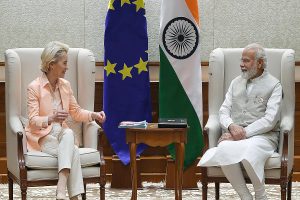Sri Krishna Janmashtami also known as Gokulashtami is a grand festival celebrated with passionate fervour by devotees all over India and abroad to commemorate the birth of Lord Krishna, a reincarnation of Lord Vishnu, in Dapar, one of the four Yugas in Hinduism. He gave the message of Bhagavad Gita. It is an important festival, particularly in the Vaishnavism tradition of Hinduism. The Auspicious Day: According to the Hindu almanac, the auspicious day is observed annually on the Ashtami (8th day) of Krishna Paksha (dark fortnight) that falls in Shravana or Bhadrapad.
As per the Gregorian calendar, Janmashtami is celebrated in the month of August or September. This year the celebration will be observed on August 26. The day is a gazetted holiday in many states including Uttar Pradesh, Madhya Pradesh, Bihar, Gujarat, Haryana, Punjab, Orissa Tamil Nadu, Nagaland, Sikkim and so on. Manifestation of God on Earth: Once Mother Earth, laden with the load of sins due to unabated tyranny perpetrated by vicious kings and rulers, prayed to Lord Brahma, the creator of the Universe, to give her respite. Then Lord Brahma entreated Lord Vishnu for reincarnation to relieve her of these evil rulers. Lord Vishnu granted the prayer.
Advertisement
Kamsa, the King of Mathura: Kamsa or Kansa was a tyrant ruler of the Vrishni Kingdom. The capital of his kingdom was Mathura. Kansa was born to King Ugrasena and Queen Padmavati. He, guided by Banasura and Narakasura, made up his mind to usurp the throne of Mathura overthrowing his father. Though Kansa is described as human in early sources, he is described as a demon king in the Puranas. Named after his royal palace Bhoja, he is also called as Bhojapati. According to Padma Purana, Kansa was not the biological son of Ugrasena. Padmavati while loitering in the garden was beheld by a supernatural being Dramila who transformed himself into her husband’s shape and seduced her. When the truth was revealed, Padmavati cursed Dramila to go down to hell. She even hated her son Kansa so much that she cursed him to be slain by a member of his clan. Devaki, Kansa’s beloved sister, was married to Vasudeva. Ominous Oracle and the birth of
Balaram: While taking his sister to her in-laws’ house, Kansa heard an ominous oracle that he would be killed by Devaki’s eighth son. Scared, he imprisoned his sister with her husband to fulfil his vow of destroying every child of Devaki and Vasudeva. Devaki faked a miscarriage during the birth of her seventh child Balrama. The embryo was miraculously transported to the womb of Rohini, the surrogate mother of Balaram. Seeing all the children being killed by cruel Kansa, the imprisoned couple feared giving birth to their eighth child. Birth of Lord Krishna: On the auspicious night of Krishna’s birth, the weather was inclement.
The cell where Devaki and Vasudeva were imprisoned was illuminated with bright light when the new born Krishna saw the light of the earth. A divine voice instructed Vasudeva to carry Krishan across the holy river Yamuna and leave him with the care and protection of his dearest friend Nandaraja. According to Harivamsha and other Puranas, Nanda, Mandaladhish (the chief) of Gokul, and his wife Yashoda were the foster parents of Krishna. Coincidentally, Nandaraja and his wife had also given birth to a baby girl that very night. However, according to the divine voice, Vasudeva crossed the turbulent Yamuna. The Brobdingnagian multi-headed Shesh Naag with his huge hood protected the child and helped Vasudeva to carry the baby across the river.
Vasudeva and Nandaraja swapped their babies. Then Vasudeva came back to the prison with the baby girl. King Kansa, apprised of the birth of the eighth child of Devaki, hurled the baby girl against the wall of the prison. But the baby was not an ordinary one. She was the incarnation of Goddess Durga who prophesied “Tomare Badhibe Je, Gokule Bardiche Se” (The person who will slain you, is growing in Gokul). However, Kansa turned down the veracity of the prophecy as he was sure to kill all the children of Devaki. Observation of Krishna’s
Birthday: The birth anniversary of Lord Krishna is observed with pomp and grandeur in Mathura and Vrindavan, the two places where Krishna was born and brought up. However, other Vashanabites and non-sectarian communities found in Assam, Manipur, West Bengal, Bihar, Odisha, Madhya Pradesh Maharashtra, Gujarat, Karnataka, Kerala, Andhra Pradesh and others also celebrate the day with pomp and grandeur.
Various Rituals: The devotees on the preceding day keep a night vigil and observe fasting until midnight, the auspicious moment of Krishna’s birth. The devotees on the day of fasting take Sankalpa (holy pledge) after the completion of morning rituals and perform Krishna Puja during Nishita Kaal which is midnight as per Vedic time-keeping. Dance-drama enactments according to the Bhagavata Purana popularly known as Rasa Lila and Krishna Lila and devotional songs are organized in many regions including Mathura, in north eastern provinces like Assam, Manipur and in Rajasthan and Gujarat. Temples and houses are decorated with flowers, leaves. Elaborate arrangements are done in commemoration of various events regarding Krishna’s life in Mathura, the river Yamuna and Gokula (ancient Vraja).
Dahi Handi: Krishan Janmashtami is incomplete without Dahi Handi (earthen pot of yogurt), a festival of team sport. It is observed the day after Janmashtami. Despite plenty of production in Gokula, children were denied nourishment. King Kansa ordered all the milk products to be preserved and sent to him. But mischievous Krishna with his accomplices stole butter and was called Makkhan Chor (butter thief). Therefore, people would hang the pots of milk products i.e. butter and yogurt high on the ceiling beyond baby Krishna’s reach.
But Krishna, full of ingenuity, would reach the pots by riding on human pyramids formed by his friends. This story symbolising mischief-mongering childhood innocence can be traced in the reliefs of Hindu temples, literatures and dancedrama repertoires. The festival of Dahi Handi is the re-enactment of this impish activity of Bal Krishna and his companions. The festival is recognized as having different nomenclatures in different regions. An earthen pot filled with milk products and sweets is hung from tall poles or ropes tied across buildings. Govinda teams, surrounded by girls cheering, teasing and hindering them from reaching the pot, form human pyramids and at last break the pot.
Celebration outside India: Janmashtami is celebrated abroad including in Nepal, Bangladesh, Pakistan, Fiji, Caribbean countries including Jamaica, Trinidad and Tobago, the Dutch colony of Surinam, US and so on. Janmashtami is a national holiday in Bangladesh. Besides, some temples and shrines including Sri Radha Giridhari Temple in Auckland in New Zealand, the Richmond Hill Hindu Temple in Canada, Sri Lakshminarayan Temple in Singapore, Sri Sri Radha Parisisvara Temple in Paris and in temples in Kuala Lumpur celebrate Janmashtami with much enthusiasm.
(The writer is a freelance contributor.)











